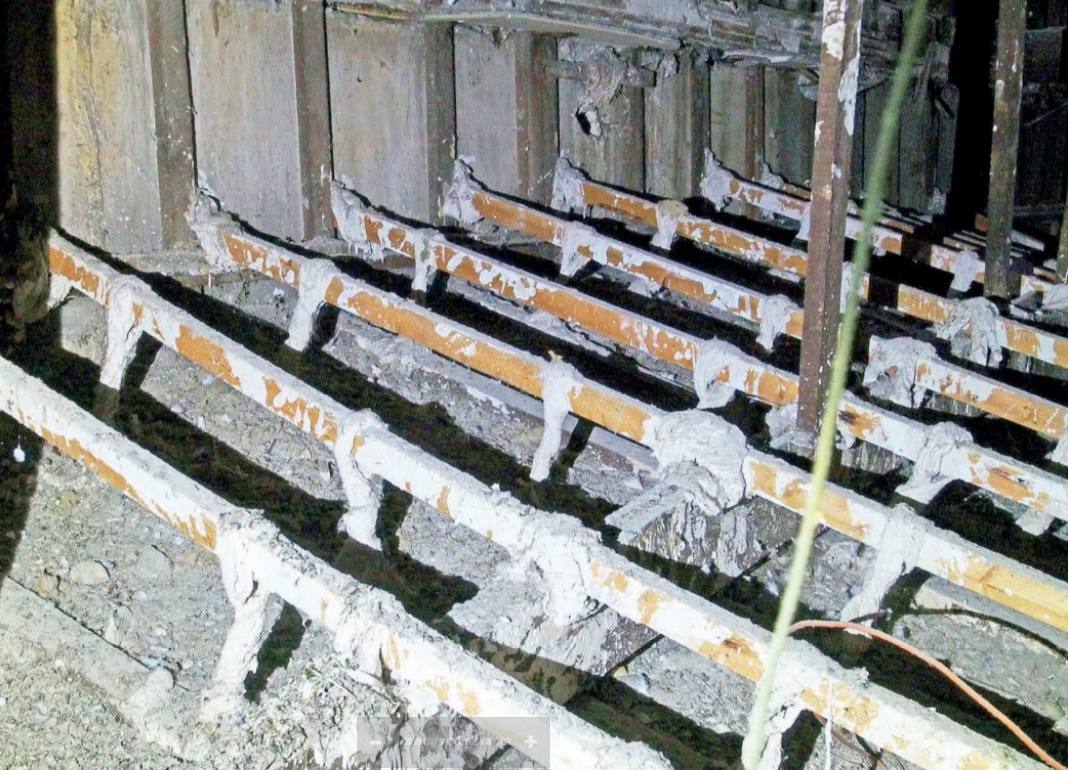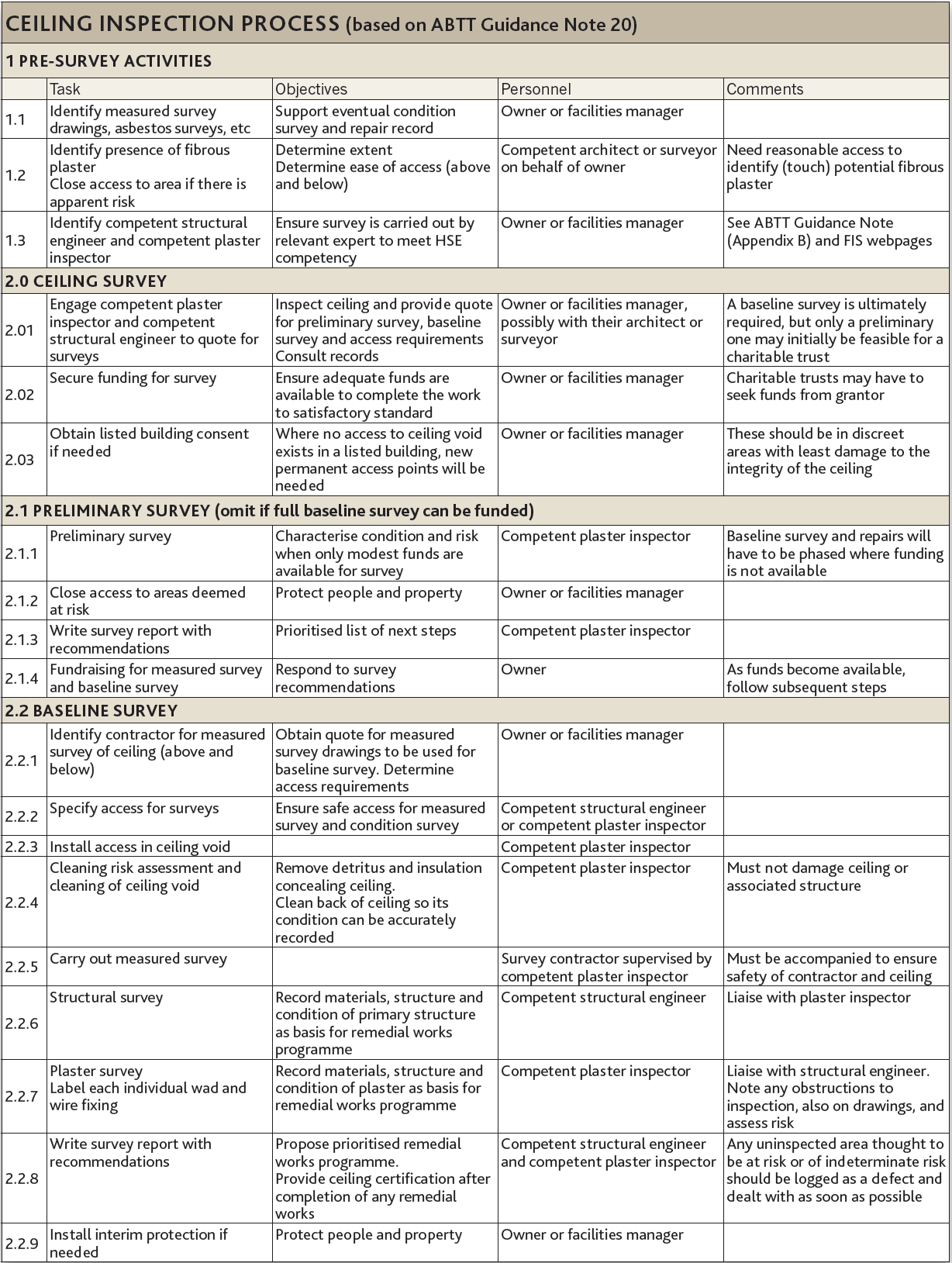Inspecting historic fibrous plaster ceilings
The risk of collapse of fibrous plaster ceilings is being addressed by a review of current practices throughout the theatre industry.

|
| The void over a fibrous plaster ceiling, showing the fibrous plaster panels fixed to the original timber structure (below), with new reinforcement wads attached to new timber (above) (Photo: Richard Ireland, © Historic England). |
Contents |
Introduction
Fibrous plaster is composed of gypsum plaster reinforced with sheets of hessian and timber. Its advantages were numerous: relatively light in weight; cheap to produce; fabricated off-site; and quickly installed. Fibrous plaster ceilings were either fixed (nailed directly to the structure or on to an intermediate timber system); or suspended (secured by means of ‘wads’ of hessian and plaster, sometimes reinforced with wire, to a framework of timber battens fastened to the structure).
Fibrous plaster was patented in the UK in 1856 but did not enter widespread use until the 1880s. It was employed extensively in cultural, commercial, institutional and high-status residential buildings up to the second world war. It was also used for repair work or restoration carried out in earlier buildings.
Despite the ubiquitous use of fibrous plaster in such buildings over this period, there is an astonishing lack of guidance on its characteristics, inspection and repair. This is because surveys and repairs are managed by a small number of busy, specialist contractors, and perhaps because demand for guidance is low, on account of owners, facilities managers or their surveyors and architects being completely unaware of its existence within their properties.
All fibrous plaster ceilings, like those of plaster and lath, may be at risk of collapse if inadequately monitored, maintained and repaired. Ceiling collapse can cause serious injury or fatality. Failure can occur in suspended ceilings through natural ageing of unreinforced wads under strain, and both suspended and fixed ceilings are vulnerable to water damage from leaky roofs or plumbing. The overall condition can also be compromised by failure of structural elements, or by mechanical installations.
In 2013 the collapse of an area of fibrous plaster ceiling in the Apollo Theatre, London, injured a number of people. Such incidences are extremely rare. Following this incident, building and health-and-safety professionals reviewed current practice throughout the industry, and recognised a need for improvements to survey standards and competency requirements. With representatives from the theatre sector, swift action was taken to draw up guidelines to ensure that ceilings are properly inspected and maintained. The outcome was the promulgation of Guidance Note 20: Advice to Theatre Owners and Managers Regarding Suspended Fibrous Plaster Ceilings: survey, certification, record keeping etc by the ABTT (Association of British Theatre Technicians). This was based on consultation between the ABTT, the Health and Safety Executive, the Theatres Trust, theatre owners (Society of London Theatre and UK Theatre), building professionals, heritage representatives and specialist fibrous plaster companies.
The guidance is addressed to theatres, where suspended ceilings are common. It constitutes the standard required to give formal certification that the premises are safe for public access. All theatres were required to carry out inspections following its recommendations by 1 September 2016. However, it is relevant to any building where fibrous plaster ceilings are found. Architects and surveyors responsible for buildings of the period described above are advised to identify if suspended ceilings are present, and follow recommendations in the guidance. As fixed ceilings can also fail, they should be subject to the same considerations. Fibrous plaster is easily distinguished from lath and plaster by a very hollow sound upon tapping.
This article summarises the ABTT guidance with regard to inspection and how it would be carried out in all buildings. The document should be consulted for its full recommendations.
Summary of ABTT Guidance Note 20
The principles
- The structural parts supporting suspended fibrous plaster ceilings should be inspected by and a report confirming their satisfactory condition be provided by a competent structural engineer.
- The plaster parts of a suspended fibrous plaster ceiling should be inspected and certified as satisfactory by a competent plaster inspector.
- All suspended fibrous plaster ceiling surfaces should be inspected from both above and below unless access is not possible.
- To determine source(s) of any past, present and future water ingress and building movement, all relevant interior and exterior parts of the theatre should be inspected.
- Ceilings should be inspected regularly and each inspection report should make recommendations for individual timescales for re-inspection.
- A thorough one-off baseline survey of existing conditions should be carried out by a competent structural engineer and by a competent plaster inspector.
- The output is a clear, detailed, documented record (including sketches and photographs) of the construction of the ceiling and how it is supported from the main structure of the building.
- To enable access to ceilings from above or below, inspection hatches, platforms or other means of observing ceilings should be considered.
- Until any such necessary methods are employed, the ceiling should be regularly monitored for changes clearly visible to the eye and the advice of a plaster specialist sought as to any interim measures that are necessary.
Unreinforced wadding ties
- If it is not reasonably practicable to gain access to a suspended fibrous plaster ceiling from above or below, it should be presumed that unreinforced hessian wadding ties (without wire) may have been used.
- If plain (unreinforced) hessian wadding ties have been found to be present and there is evidence of failure in any, consideration should be given to the consequences of further failures.
Obstructions to inspection
- Any obstructions to the visual inspection of suspended fibrous plaster ceilings should be removed wherever reasonably practicable.
Cleanliness of ceiling voids
- Ceiling voids (the volumes above ceilings) should be cleaned to such a standard as to allow reasonable visual inspection of all attachment points.
Caveats and disclaimers
- The conclusions and expert advice as to matters of fact contained in inspection reports and surveys provided by structural engineers and plaster inspectors should be expressed as clearly and categorically as possible.
- The structural engineer or plaster inspector carrying out the inspection or survey should not seek to limit or exclude liability through a general or blanket limitation.
Re-inspection intervals
- The baseline survey and each subsequent inspection should give recommendations as to the maximum interval before the next inspection of the various suspended fibrous plaster ceilings.
- Theatre operators and employers should compile and maintain a register of all suspended fibrous plaster ceilings in their theatre.
- The baseline survey should form the basis for all future inspection and maintenance of suspended fibrous plaster ceilings.
- Ceiling ‘certificates’ should be obtained as confirmation and evidence that the premises may be safely opened to the public in accordance with the latest guidance in the Technical Standards for Places of Entertainment.
- Inspection, repair work and maintenance should be carried out by competent persons of sufficient demonstrable experience (both in the technical aspects of the work, and compliance with current health-and-safety regulations) in the inspection and maintenance of theatres with suspended fibrous plaster ceilings.
Practical application of the guidance
The following table frames the processes recommended in the guidance. Where funds are not available for a baseline survey, it proposes a preliminary survey to assess and manage risk. This is also recommended by the FIS (Finishes and Interiors Sector), the trade association for plasterers.
The ABTT guidance note constitutes the new standard by which all fibrous plaster ceilings should be assessed. The heightened awareness of fibrous plaster ceilings is prompting other initiatives. The FIS has a dedicated heritage group that has created additional guidance on survey format and determination of competency. Historic England is working with various partners, including the Theatres Trust, the FIS and specialist fibrous plaster companies, on several research streams to better understand and manage this material.
References
- Association of British Theatre Technicians, Chartered Institute of Environmental Health, District Surveyors Association, Institute of Licensing (2015), David Adams (ed) Technical Standards for Places of Entertainment, Entertainment Technology Press, Great Shelford, Cambridge
- Harrison, David (1999) ‘Dramatic plasterwork: fibrous plaster in theatres’, Building Conservation Directory
- Health and Safety Executive, What is Competence?
This article originally appeared in IHBC’s Context 154, published in May 2018. It was written by John Stewart, senior architectural conservator at Historic England, and co-editor of Mortars, Renders and Plasters (Ashgate, 2012).
--Institute of Historic Building Conservation
Related articles on Designing Buildings
- Ceiling.
- Conservation officer.
- Conservation.
- Hot-mixed mortars: the new lime revival
- IHBC articles.
- Lime mortar.
- Lime plaster.
- Mortar.
- Plaster.
- Stucco.
- The Institute of Historic Building Conservation.
- The use of lime mortar in building conservation.
- Types of mortar.
- Types of suspended ceiling systems.
IHBC NewsBlog
Old Sarum fire in listed (& disputed) WW1 Hangar - Wiltshire Council has sought legal advice after fire engulfed a listed First World War hangar that was embroiled in a lengthy planning dispute.
UK Antarctic Heritage Trust launches ‘Virtual Visit’ website area
The Trust calls on people to 'Immerse yourself in our heritage – Making Antarctica Accessible'
Southend Council pledge to force Kursaal owners to maintain building
The Council has pledged to use ‘every tool in the toolbox’ if urgent repairs are not carried out.
HE’s Research Magazine publishes a major study of the heritage of England’s suburbs
The article traces the long evolution of an internal programme to research 200 years of suburban growth
IHBC Context 183 Wellbeing and Heritage published
The issue explores issues at the intersection of heritage and wellbeing.
SAVE celebrates 50 years of campaigning 1975-2025
SAVE Britain’s Heritage has announced events across the country to celebrate bringing new life to remarkable buildings.
IHBC Annual School 2025 - Shrewsbury 12-14 June
Themed Heritage in Context – Value: Plan: Change, join in-person or online.
200th Anniversary Celebration of the Modern Railway Planned
The Stockton & Darlington Railway opened on September 27, 1825.
Competence Framework Launched for Sustainability in the Built Environment
The Construction Industry Council (CIC) and the Edge have jointly published the framework.
Historic England Launches Wellbeing Strategy for Heritage
Whether through visiting, volunteering, learning or creative practice, engaging with heritage can strengthen confidence, resilience, hope and social connections.















